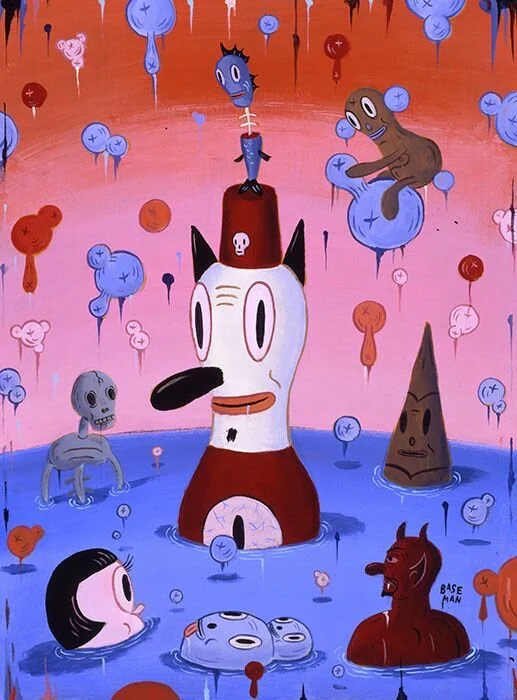My 10 Most Influential Works of Art
As we reflect during this time of isolation, we are compelled to think about the impact of the arts on our lives and society. Collectively, we don’t know what the future holds or what the world post-pandemic will be like, but we anticipate it might be different than we are used to. And while we eagerly await the days when we can safely visit galleries and museums to see artwork in person, we thought it would be fun to investigate how and what artistic influences have shaped our respective perspectives.
So, we asked the question of our staff, “What pieces of art have had the biggest influence on you?”
Our Exhibitions and Programs Manager, Ari Foster, shares her answers:
Hello everyone, I’d like to preface my selections by mentioning that I have a background in illustration. While I have taken much inspiration from all art periods and styles my selections will favor illustrative and narrative influences from my childhood through now.
The Beguiling of Merlin by Edward Byrne Jones
One summer in elementary school I’d decided to take an Arthurian legend class that ended up being the catalyst of my love for mythology and legend. I attended a small K-8 school and Ms. Doody (yes, that’s her real name) was a stern but eccentric teacher. She taught a multitude of classes throughout my time there, though the thing I remember most was her love of storytelling. She’d read to us during class breaks and to this day, her rendition of The Princess Bride is my favorite. This particular painting was a full page spread in one of her Arthurian legend books that I’d borrowed during that summer. Years later it continues to be one of my favorite books to reference, and I take a peek at this image any time I reach for it.
A cover for La Vie Parisienne by Georges Leonnec
You know how teenagers go through “phases”? I went through an Art Nouveau phase. I was absolutely enamored with line and form that was integral to this art style. While this image is perhaps not the best example of the intricate filigree most people are familiar with, I love it all the same. I particularly enjoy Nouveau era advertisements and magazine covers, they are enticing, delicate, vain, and sultry.
Concept art for Disney’s Sleeping Beauty by Eyvind Earle
If there were a more apt definition for the word ‘lush’ it would be images of Earle’s paintings. I remember watching a short video when I was in college titled ‘4 Artists Paint 1 Tree’ that depicts 4 Disney illustrators creating vastly different interpretations of the same tree. It was a life changing moment to see the stark differences in approach and technique that I was absolutely blown away. I still am. Earle’s approach to background painting, guaranteed, has influenced some of the top animators, illustrators, and painters of today.
Coraline book cover by Dave McKean
One fateful day during my 4th grade library period, I’d discovered this odd book and was intrigued its spookiness. This began my love affair with Neil Gaiman novels and Dave McKean’s accompanying illustrations were the perfect amount of terrifying for this particular story. As I grew older, I devoured all I could find from Gaiman and McKean. They’re a pair that work exceptionally well together, and their work has followed me throughout my artistic career.
The Baptism of Toby by Gary Baseman
Gary Baseman was one of the first artists I sought to emulate, and a huge influence to some of the worlds and characters I created in my artistic infancy. His “Pervasive Art” movement was revolutionary to me at an integral time in my life, and his character Toby will forever be one of my artistic idols.
A page from Little Bear’s Visit illustrated by Maurice Sendak
I will credit Little Bear as being my main introduction to Maurice Sendak and his illustrations. From 7 Little Monsters to Where the Wild Things Are, I have always appreciated Sendak’s “fuzzy” linework and creature designs.
Tekkonkinkreet by Taiyo Matsumoto
The world building in this comic/manga series by Taiyo Matsumoto is astounding. It’s chock full of little details that are a feast for the eyes. The film adaptation is also a must-watch, animation Studio 4°C imparts a new life into this already exuberant story.
A page from The Osbick Bird by Edward Gorey
I love Edward Gorey’s eccentric illustrations and stories, I chose this particular illustration as an homage to my childhood desk/work area. I was gifted an Edward Gorey calendar and at one point forgotten to rip the next page off and on this image it stayed for many years. It still hangs on my wall, to this day.
Untitled illustration by Yoshitaka Amano
There’s a strange finesse to Amano’s paintning style and linework that I adore. His career spans many decades from comics and manga to high fashion and commercial work. His style is truly unique.
The Swing by Jean Fragonard
One of the things that gravitated me towards illustration was the sense of frivolity that I craved outside of studio art. What is more frivolous and excessive than the Rococo era? This piece is romantic, decadent, luscious, and obnoxiously over the top. A perfect example of one of the most deliciously dramatic periods of art history.












![Q&A [Question and Artist]: Perin Mahler](https://images.squarespace-cdn.com/content/v1/58bb213420099e5b48771d3b/1585207854549-ZJVOSZ2L8QVK70FGTPH5/29.jpg)
